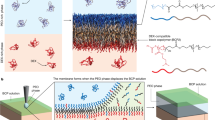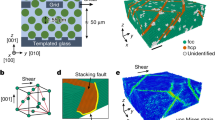Abstract
IT is generally assumed, in colloidal systems, that the hydrocarbon carrier plays a negligible part in determining the effectiveness of surface-active agents. We have carried out scuffing experiments using a 4-ball machine which show this is not always true. The machine consisted of three 1-in. hard steel balls clamped together in a cup and flooded with lubricant, with a 4th ball loaded against the other three, such that the centres of the four are at the corners of a tetrahedron. The 4th (top) ball is rotated at speeds up to 200 r.p.m. The solvents were straight-chain paraffins and the surface-active agents long-chain acids, amines, and alcohols, in 0.3 per cent molar concentrations. The number of carbon atoms in the agents were varied and the loads on the top ball increased in 15-lb. increments (at about 5-min intervals) until scuffing started. This point was marked by definite stick slip oscillations, and an increase in friction.
This is a preview of subscription content, access via your institution
Access options
Subscribe to this journal
Receive 51 print issues and online access
$199.00 per year
only $3.90 per issue
Buy this article
- Purchase on Springer Link
- Instant access to full article PDF
Prices may be subject to local taxes which are calculated during checkout
Similar content being viewed by others
References
Siripongse, C., Rogers, P. R., and Cameron, A., Engineering, 186, 146 (1958).
Author information
Authors and Affiliations
Rights and permissions
About this article
Cite this article
CAMERON, A., CROUCH, R. Interaction of Hydrocarbon and Surface-active Agent. Nature 198, 475–476 (1963). https://doi.org/10.1038/198475a0
Issue Date:
DOI: https://doi.org/10.1038/198475a0
This article is cited by
-
Complex Impedance Measurement Applied to Short-Time Contact Between Colliding Steel Surfaces
Tribology Letters (2015)
Comments
By submitting a comment you agree to abide by our Terms and Community Guidelines. If you find something abusive or that does not comply with our terms or guidelines please flag it as inappropriate.



